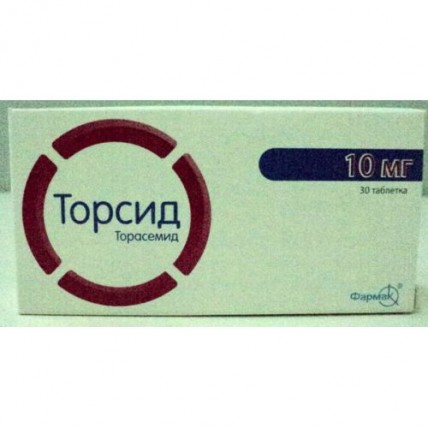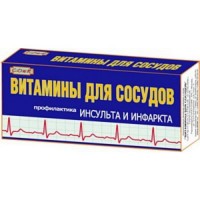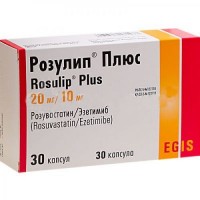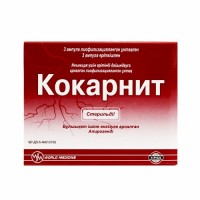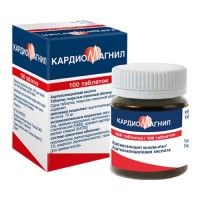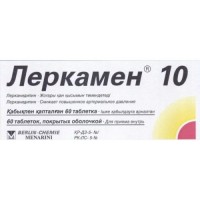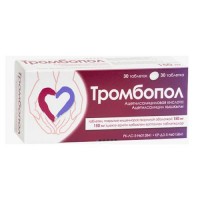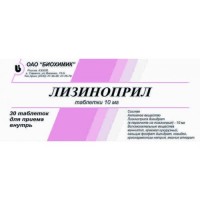Torsida 10 mg (30 tablets)
- $11.70
Out Of Stock
The instruction for medical use
of TORSID medicine
the Trade name
Torsid
Mezhdunarodnoye the unlicensed
name Torasemid Lekarstvennaya a form
of the Tablet, 5 mg or 10 mg
Structure
One tablet contains
active agent - torasemid in terms of 100% substance of 5 mg or 10 mg,
excipients: lactoses monohydrate (tabletoza 80), starch prezhelatinizirovanny (Starch 1500), silicon dioxide colloidal anhydrous, magnesium stearate.
The description
of the Tablet of white or almost white color with a flat surface with risky and a facet.
Pharmacotherapeutic group
Diuretics. Loopback diuretics. Sulfanamide diuretics.
The code of automatic telephone exchange C03CA04
the Pharmacological
Pharmacokinetics Later properties of intake is quickly and almost completely soaked up from a digestive tract. The maximum concentration in blood plasma is observed in 1-2 h. Linking of a torasemid with proteins of plasma makes more than 99%, metabolites of M1, M3 and M5 – 86%, 95% and 97% respectively. The bioavailability is about 80% with insignificant individual variations and does not depend on meal. It is metabolized in a liver by the system of P450 cytochrome with formation of metabolites (M1, M3 and M5). The main metabolite of M5 of diuretic effect does not render, the operating metabolites of M1 and M3 in common cause about 10% of pharmakodinamichesky action. Elimination half-life of a torasemid and its metabolites at healthy volunteers makes 3 – 4 h. About 83% of the accepted dose are removed through renal tubules: in not changed look (24%) and in the form of metabolites (M1 – 12%, M3 – 3%, M5 – 41%). The general clearance is 40 ml/min., renal clearance - about 10 ml/min. In a renal failure the general clearance and elimination half-life of a torasemid do not change, and elimination half-life of M3 and M5 is extended. However pharmakodinamichesky characteristics remain invariable, the severity of a renal failure does not influence action duration. At patients with abnormal liver functions or with heart failure the elimination half-life of a torasemid and metabolite of M5 is slightly extended, cumulation of a torasemid and its metabolites is not observed.
A pharmacodynamics
the Main mechanism of diuretic action is caused by reversible linking with a kotransporter of Na+/2Cl-/K + in an apical membrane of a thick segment of the ascending part of a Henle's loop owing to what decreases or the renal reabsorption of ions of sodium and chlorine in the ascending part of a Henle's loop is completely oppressed, the osmotic pressure of intracellular liquid and a reabsorption of water decreases. In the range of doses of 5 - 100 mg the increase in a diuresis is proportional to a dose logarithm. Increase in a diuresis arises and when other diuretic drugs (for example, tiazida) do not render sufficient effect, for example, at bounded function of kidneys any more. Eliminates swell, has antihypertensive effect which is caused by reduction of peripheric resistance of vessels due to reduction of content of free calcium in cells of a muscular layer of arteries and normalization of the broken electrolytic balance. Thereof the contractilnost and reaction of vessels to own pressor substances of an organism, in particular catecholamines decreases. Improves operating conditions of heart due to reduction before - and afterloads. After oral administration the maximum diuretic action continues 1 - 3 h, and the diuretic effect remains for nearly 12 h. Hypotensive effect of drug develops gradually within the first week and reaches a maximum no later than 12 weeks.
Indications
- arterial hypertension
- an edematous syndrome owing to the chronic heart failure, diseases of a liver, kidneys slight
Appoint the Route of administration and doses to adults and children 12 years are more senior. Accept in 1 times a day in the morning after a meal, without chewing, wash down with a small amount of liquid. The dose and duration of a course of treatment are established individually taking into account indications, efficiency and shipping of therapy.
In arterial hypertension. Usually the dose makes 2.5 mg of Torsid. If after 12 weeks therapy by drug in a dose of 2.5 mg a day the normalization of arterial blood pressure is not reached, it is possible to increase a dose to 5 mg. Further increase in a dose is inexpedient because it will not lead to a further lowering of arterial pressure.
At an edematous syndrome: the initial dose makes 5 mg of Torsid a day, at insufficiently significant effect the dose can be raised, depending on disease severity, to 20 mg of drug a day.
Side effects
Often
- disturbances of water and electrolytic balance (hypovolemia, a hypopotassemia, a hyponatremia)
- a headache, dizziness, increased fatigue, spasms
- anorexia, nausea, vomiting, a stomach ache, diarrhea, a constipation, increase in activity of some enzymes of a liver (in particular, gamma glutamiltranspeptidazy)
- arterial hypotension, confusion of consciousness (at considerable losses of liquid and electrolytes, owing to strong urination)
- at patients with urination disorders (for example, in a prostatauxe) intensive urination can lead to an ischuria and hyperdystension of a bladder
Seldom
- increase in level of uric acid, glucose, lipids (triglycerides, cholesterol), creatinine and urea in blood
- thrombocytopenia, an erythropenia and/or a leukopenia
- dryness in a mouth
- paresthesias
In isolated cases
- a metabolic alkalosis
- thrombosis, cardial and cerebral ischemia with possible development of disturbances of a warm rhythm, stenocardia, acute myocardial infarction, a syncope
- an itching, a dieback, photosensitivity, heavy skin reactions
- disorders of vision, sonitus,
the Contraindication hearing impairment
- arterial hypotension
- the renal failure which is followed by an anury
- heavy abnormal liver functions with a loss of consciousness (hepatic coma or a prekoma)
- a hypovolemia, a hyponatremia, a hypopotassemia
- the significant disturbances of a mochevyvedeniye (for example, as a result of a prostatauxe)
- gout
- high degree of cardiac conduction abnormalities (for example, sinuatrial or atrioventricular block ІІ or ІІІ degrees)
- pathological changes of acid-base balance
- simultaneous therapy by lithium drugs, aminoglycosides or cephalosporins
- pathological changes of a picture of blood (for example, thrombocytopenia or anemia at patients without renal failure)
- the renal failures caused by nephrotoxic substances
- children's age up to 12 years
- pregnancy, the feeding period a breast
- the increased individual sensitivity to a torasemid, related with it on structure to substances (compounds of sulfanylurea) and/or other components of drug
Medicinal interactions
Torsid strengthens effect of other antihypertensive medicines, in particular inhibitors of angiotensin-converting enzyme therefore the corresponding combination therapy can lead to an excessive lowering of arterial pressure.
At simultaneous use with Torsid of foxglove drugs the deficiency of potassium caused torasemidy can lead to expansion of range of side effect of both drugs.
Torsid weakens action of antidiabetic means. Probenetsid and non-steroidal anti-inflammatory drugs weaken diuretic and hypotensive action of Torsid. At therapy by salicylates in high doses Torsid can strengthen their toxic action on the central nervous system. Torsid, especially in high doses, can strengthen from - and nephrotoxic action of aminoglikozidny antibiotics and derivatives of platinum. Torsid strengthens effect of theophylline and kurarepodobny muscle relaxants. Depletive and also mineralo- and glucocorticoids can strengthen the possible loss of potassium caused by Torsid. At simultaneous use of Torsid and drugs of lithium the concentration of lithium in blood and by that to amplify effect of lithium and its side effects can increase. Torsid weakens vasoconstrictive action of catecholamines. At simultaneous use with holestiraminy the absorption of a torasemid can decrease and by that its action can be weakened.
Special instructions
At long therapy by Torsid the regular control of electrolytic balance (in particular serum potassium), the level of glucose, uric acid, creatinine and lipids in serum of blood, a blood picture is necessary.
It is necessary to consider that increase in level of glucose in blood of the patient can be connected with possible latent or manifest diabetes therefore such patients should carry out careful control of level of sugar of blood.
Drug should be used with care at patients with cardiac arrhythmias, the patient of advanced age with the profound atherosclerosis, against the background of long therapy by cardiac glycosides.
Patients with a prostatauxe and disturbances of urination need to appoint drug with care as intensive urination can lead to a delay of urination and a cystectasia.
The feature of influence of medicine on ability to run the vehicle or potentially dangerous mechanisms
should not use drug during driving or other potentially dangerous mechanisms, the psychomotor reactions demanding speed and the increased concentration of attention.
Overdose
Symptoms: strengthening of a diuresis with danger of loss of liquid and electrolytes, drowsiness, confusion of consciousness, arterial hypotension, collapse and disorders of function of a digestive tract.
Treatment: drug withdrawal, treatment on normalization of water and electrolytic balance: at a hypopotassemia appoint 7.4% chloride potassium solution (in an alkalosis) or 10% hydrocarbonate potassium solution (in acidosis), in both cases – as addition to carrier solution, at a hyponatremia – 5.8% solution of sodium of chloride or 8.4% bicarbonate sodium solution (in simultaneous acidosis), in both cases – as addition to carrier solution. There is no specific antidote.
A form of release and packing
of the Tablet on 5 mg or 10 mg. On 10 tablets in blister strip packaging (blister) from a film of the polyvinylchloride colourless and printing aluminum foil varnished. On 1 or 3 blister strip packagings together with the instruction for medical use in the state and Russian languages place in a pack from cardboard.
To Store storage conditions in the dry, protected from light place at a temperature not above 25 °C. To store out of children's reach!
2 years
not to use a period of storage after expiry date.
Prescription status
According to the prescription
JSC Pharmak Adres Producer: Ukraine, 04080, Kiev, st. of Frunze, 63.
The address of the organization accepting in the territory of the Republic of Kazakhstan claims from consumers on quality of products (goods)
Republic of Kazakhstan, 050034 Almaty, Brodsky St., 37A, office 217,
Ph. / fax: +7 (727) 227-37-21 (22)
E-mail:
To Develop znamer@ukr.net
of TORSID medicine
the Trade name
Torsid
Mezhdunarodnoye the unlicensed
name Torasemid Lekarstvennaya a form
of the Tablet, 5 mg or 10 mg
Structure
One tablet contains
active agent - torasemid in terms of 100% substance of 5 mg or 10 mg,
excipients: lactoses monohydrate (tabletoza 80), starch prezhelatinizirovanny (Starch 1500), silicon dioxide colloidal anhydrous, magnesium stearate.
The description
of the Tablet of white or almost white color with a flat surface with risky and a facet.
Pharmacotherapeutic group
Diuretics. Loopback diuretics. Sulfanamide diuretics.
The code of automatic telephone exchange C03CA04
the Pharmacological
Pharmacokinetics Later properties of intake is quickly and almost completely soaked up from a digestive tract. The maximum concentration in blood plasma is observed in 1-2 h. Linking of a torasemid with proteins of plasma makes more than 99%, metabolites of M1, M3 and M5 – 86%, 95% and 97% respectively. The bioavailability is about 80% with insignificant individual variations and does not depend on meal. It is metabolized in a liver by the system of P450 cytochrome with formation of metabolites (M1, M3 and M5). The main metabolite of M5 of diuretic effect does not render, the operating metabolites of M1 and M3 in common cause about 10% of pharmakodinamichesky action. Elimination half-life of a torasemid and its metabolites at healthy volunteers makes 3 – 4 h. About 83% of the accepted dose are removed through renal tubules: in not changed look (24%) and in the form of metabolites (M1 – 12%, M3 – 3%, M5 – 41%). The general clearance is 40 ml/min., renal clearance - about 10 ml/min. In a renal failure the general clearance and elimination half-life of a torasemid do not change, and elimination half-life of M3 and M5 is extended. However pharmakodinamichesky characteristics remain invariable, the severity of a renal failure does not influence action duration. At patients with abnormal liver functions or with heart failure the elimination half-life of a torasemid and metabolite of M5 is slightly extended, cumulation of a torasemid and its metabolites is not observed.
A pharmacodynamics
the Main mechanism of diuretic action is caused by reversible linking with a kotransporter of Na+/2Cl-/K + in an apical membrane of a thick segment of the ascending part of a Henle's loop owing to what decreases or the renal reabsorption of ions of sodium and chlorine in the ascending part of a Henle's loop is completely oppressed, the osmotic pressure of intracellular liquid and a reabsorption of water decreases. In the range of doses of 5 - 100 mg the increase in a diuresis is proportional to a dose logarithm. Increase in a diuresis arises and when other diuretic drugs (for example, tiazida) do not render sufficient effect, for example, at bounded function of kidneys any more. Eliminates swell, has antihypertensive effect which is caused by reduction of peripheric resistance of vessels due to reduction of content of free calcium in cells of a muscular layer of arteries and normalization of the broken electrolytic balance. Thereof the contractilnost and reaction of vessels to own pressor substances of an organism, in particular catecholamines decreases. Improves operating conditions of heart due to reduction before - and afterloads. After oral administration the maximum diuretic action continues 1 - 3 h, and the diuretic effect remains for nearly 12 h. Hypotensive effect of drug develops gradually within the first week and reaches a maximum no later than 12 weeks.
Indications
- arterial hypertension
- an edematous syndrome owing to the chronic heart failure, diseases of a liver, kidneys slight
Appoint the Route of administration and doses to adults and children 12 years are more senior. Accept in 1 times a day in the morning after a meal, without chewing, wash down with a small amount of liquid. The dose and duration of a course of treatment are established individually taking into account indications, efficiency and shipping of therapy.
In arterial hypertension. Usually the dose makes 2.5 mg of Torsid. If after 12 weeks therapy by drug in a dose of 2.5 mg a day the normalization of arterial blood pressure is not reached, it is possible to increase a dose to 5 mg. Further increase in a dose is inexpedient because it will not lead to a further lowering of arterial pressure.
At an edematous syndrome: the initial dose makes 5 mg of Torsid a day, at insufficiently significant effect the dose can be raised, depending on disease severity, to 20 mg of drug a day.
Side effects
Often
- disturbances of water and electrolytic balance (hypovolemia, a hypopotassemia, a hyponatremia)
- a headache, dizziness, increased fatigue, spasms
- anorexia, nausea, vomiting, a stomach ache, diarrhea, a constipation, increase in activity of some enzymes of a liver (in particular, gamma glutamiltranspeptidazy)
- arterial hypotension, confusion of consciousness (at considerable losses of liquid and electrolytes, owing to strong urination)
- at patients with urination disorders (for example, in a prostatauxe) intensive urination can lead to an ischuria and hyperdystension of a bladder
Seldom
- increase in level of uric acid, glucose, lipids (triglycerides, cholesterol), creatinine and urea in blood
- thrombocytopenia, an erythropenia and/or a leukopenia
- dryness in a mouth
- paresthesias
In isolated cases
- a metabolic alkalosis
- thrombosis, cardial and cerebral ischemia with possible development of disturbances of a warm rhythm, stenocardia, acute myocardial infarction, a syncope
- an itching, a dieback, photosensitivity, heavy skin reactions
- disorders of vision, sonitus,
the Contraindication hearing impairment
- arterial hypotension
- the renal failure which is followed by an anury
- heavy abnormal liver functions with a loss of consciousness (hepatic coma or a prekoma)
- a hypovolemia, a hyponatremia, a hypopotassemia
- the significant disturbances of a mochevyvedeniye (for example, as a result of a prostatauxe)
- gout
- high degree of cardiac conduction abnormalities (for example, sinuatrial or atrioventricular block ІІ or ІІІ degrees)
- pathological changes of acid-base balance
- simultaneous therapy by lithium drugs, aminoglycosides or cephalosporins
- pathological changes of a picture of blood (for example, thrombocytopenia or anemia at patients without renal failure)
- the renal failures caused by nephrotoxic substances
- children's age up to 12 years
- pregnancy, the feeding period a breast
- the increased individual sensitivity to a torasemid, related with it on structure to substances (compounds of sulfanylurea) and/or other components of drug
Medicinal interactions
Torsid strengthens effect of other antihypertensive medicines, in particular inhibitors of angiotensin-converting enzyme therefore the corresponding combination therapy can lead to an excessive lowering of arterial pressure.
At simultaneous use with Torsid of foxglove drugs the deficiency of potassium caused torasemidy can lead to expansion of range of side effect of both drugs.
Torsid weakens action of antidiabetic means. Probenetsid and non-steroidal anti-inflammatory drugs weaken diuretic and hypotensive action of Torsid. At therapy by salicylates in high doses Torsid can strengthen their toxic action on the central nervous system. Torsid, especially in high doses, can strengthen from - and nephrotoxic action of aminoglikozidny antibiotics and derivatives of platinum. Torsid strengthens effect of theophylline and kurarepodobny muscle relaxants. Depletive and also mineralo- and glucocorticoids can strengthen the possible loss of potassium caused by Torsid. At simultaneous use of Torsid and drugs of lithium the concentration of lithium in blood and by that to amplify effect of lithium and its side effects can increase. Torsid weakens vasoconstrictive action of catecholamines. At simultaneous use with holestiraminy the absorption of a torasemid can decrease and by that its action can be weakened.
Special instructions
At long therapy by Torsid the regular control of electrolytic balance (in particular serum potassium), the level of glucose, uric acid, creatinine and lipids in serum of blood, a blood picture is necessary.
It is necessary to consider that increase in level of glucose in blood of the patient can be connected with possible latent or manifest diabetes therefore such patients should carry out careful control of level of sugar of blood.
Drug should be used with care at patients with cardiac arrhythmias, the patient of advanced age with the profound atherosclerosis, against the background of long therapy by cardiac glycosides.
Patients with a prostatauxe and disturbances of urination need to appoint drug with care as intensive urination can lead to a delay of urination and a cystectasia.
The feature of influence of medicine on ability to run the vehicle or potentially dangerous mechanisms
should not use drug during driving or other potentially dangerous mechanisms, the psychomotor reactions demanding speed and the increased concentration of attention.
Overdose
Symptoms: strengthening of a diuresis with danger of loss of liquid and electrolytes, drowsiness, confusion of consciousness, arterial hypotension, collapse and disorders of function of a digestive tract.
Treatment: drug withdrawal, treatment on normalization of water and electrolytic balance: at a hypopotassemia appoint 7.4% chloride potassium solution (in an alkalosis) or 10% hydrocarbonate potassium solution (in acidosis), in both cases – as addition to carrier solution, at a hyponatremia – 5.8% solution of sodium of chloride or 8.4% bicarbonate sodium solution (in simultaneous acidosis), in both cases – as addition to carrier solution. There is no specific antidote.
A form of release and packing
of the Tablet on 5 mg or 10 mg. On 10 tablets in blister strip packaging (blister) from a film of the polyvinylchloride colourless and printing aluminum foil varnished. On 1 or 3 blister strip packagings together with the instruction for medical use in the state and Russian languages place in a pack from cardboard.
To Store storage conditions in the dry, protected from light place at a temperature not above 25 °C. To store out of children's reach!
2 years
not to use a period of storage after expiry date.
Prescription status
According to the prescription
JSC Pharmak Adres Producer: Ukraine, 04080, Kiev, st. of Frunze, 63.
The address of the organization accepting in the territory of the Republic of Kazakhstan claims from consumers on quality of products (goods)
Republic of Kazakhstan, 050034 Almaty, Brodsky St., 37A, office 217,
Ph. / fax: +7 (727) 227-37-21 (22)
E-mail:
To Develop znamer@ukr.net
